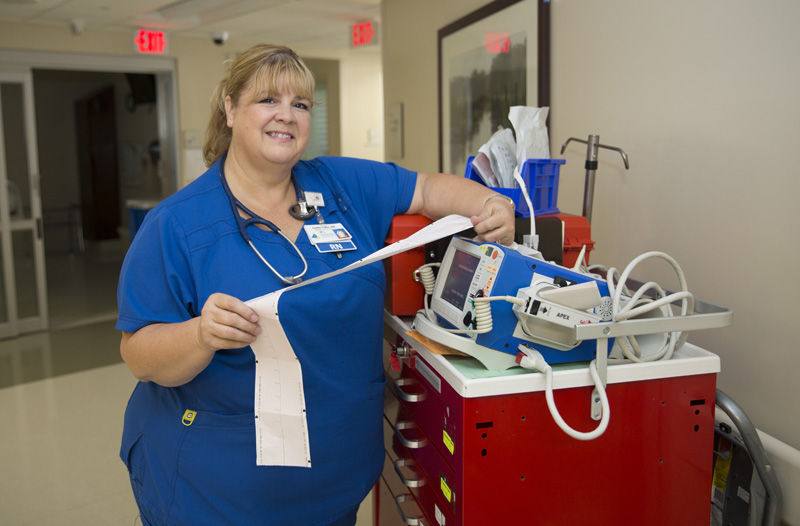Sepsis – also called septicemia or blood poisoning – is a stone cold killer.
The National Center for Health Statistics says there are more than one million cases reported annually and The Centers for Disease Control estimates that between 28 and 50 percent of those who get sepsis will die from it.
Making matters worse is the fact that recognizing the onset of sepsis isn’t always easy.
Linda Lake, director of critical care and dialysis at Sebastian River Medical Center explains: “The signs and symptoms of sepsis in our senior population are not as obvious as in other conditions such as a heart attack or stroke.”
Lake continues by pointing out that, “If not treated in the early stages, [sepsis] can become life threatening. It is important that if you have signs or symptoms of an infection such as a change in body temperature – above 101.3 degrees or below 95 degrees Fahrenheit – a rapid heart rate or rapid breathing, shaking chills or unexplained confusion, make sure you get in to see your primary care physician as quickly as you can. Sepsis can quickly turn into severe sepsis, [and eventually septic shock], so getting medical attention in a timely manner is crucial to survival.”
Sepsis is something we do to ourselves. Or, more correctly, something our bodies’ immune systems do to us.
The U.S. National Library of Medicine explains: Sepsis, it says, is brought on when the body’s immune system, “has an overwhelming response to an infection. The chemicals released into the blood to fight that infection trigger widespread inflammation. This leads to blood clots and leaky blood vessels.”
That, in turn, can cause poor blood flow and deprive the body’s organs of nutrients and oxygen, causing one or more of those organs to fail.
Anyone can develop sepsis but it is most common and most dangerous in older adults and in those with weakened immune systems.
Any type of infection including bacterial, viral or fungal can lead to sepsis. Pneumonia, abdominal infections, kidney infections and bloodstream infections lead the list.
The Mayo Clinic describes the process in dramatic terms stating flatly that the tsunami of chemicals the body releases to fight these infections brings on, “a cascade of changes that can damage multiple organ systems, causing them to fail.”
In the worst cases, according to the National Institutes of Health, “Blood pressure drops and the heart weakens, leading to septic shock,” a condition which is all-too-frequently fatal.
Most physicians view sepsis as having three separate stages starting with sepsis and progressing through severe sepsis and then onto septic shock. The goal is to treat sepsis during its mildest stages before it becomes life-threatening.
Lake, who has headed the SMRC critical care unit for the past 22 years, reports that last year the hospital saw, “154 cases of sepsis and septic shock.” That’s almost three cases a week over the course of the year.
Armed with that experience, Lake explains that, “The physicians and staff at SRMC are trained to suspect sepsis early on by paying close attention to vital signs, lab results and to follow evidence-based protocols or bundles to treat sepsis and septic shock.”
Treatment of sepsis in its earliest stage usually starts with antibiotics and large amounts of intravenous fluids but can become far more complex through severe sepsis and septic shock depending on the organs affected.
Signs of severe sepsis can include significantly decreased urine output, an abrupt change in mental status, low blood platelet counts, breathing difficulties, abdominal pains and rapid heartbeats. Septic shock would add extremely low blood pressure to that list.
The incidence of sepsis on the rise and Mayo Clinic points to three factors that likely are contributing to the trend. First, it speculates that since Americans are living longer, there are more people in the highest risk age group – people older than 65.
Secondly, the researchers at the Minnesota-based institution single out the emergence of drug-resistant bacteria. “Many types of bacteria,” they claim, “can resist the effects of antibiotics that once killed them. These antibiotic-resistant bacteria are often the root cause of the infections that trigger sepsis.”
Finally the Clinic speculates that the compromised immune systems of seniors undergoing cancer treatments or taking anti-rejection transplant drugs may also play a role in making the body more susceptible to sepsis.
Lake, who has been a critical care nurse since 1986, says her team is, “Trained to suspect sepsis early and to treat and follow-up closely with elderly patients,” but she adds that some common sense can also go a long way towards avoiding the problem altogether.
“Preventing sepsis,” Lake explains, “begins with basic prevention of contracting any infection. Proper and vigilant hand washing with either soap and water or hand-sanitizing products can decrease the chance of infections.”
Still, infections do happen and Lake delivers a worthwhile warning, “If you suspect you have an infection, see your healthcare provider. Do not hope that it will go away. If you develop a rising fever and shaking chills, seek [immediate] medical attention.”

